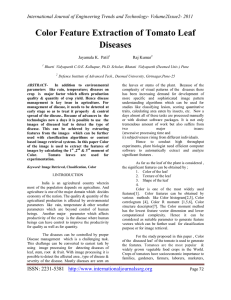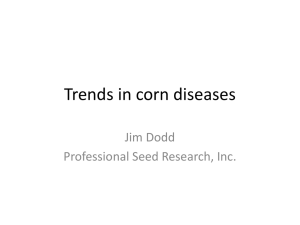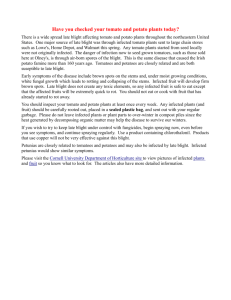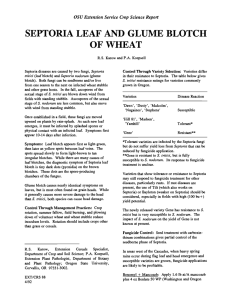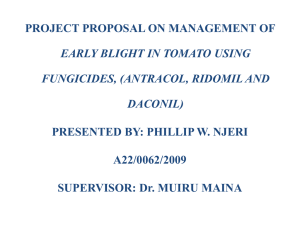T omato disorders: Early blight and Septoria leaf spot to
advertisement
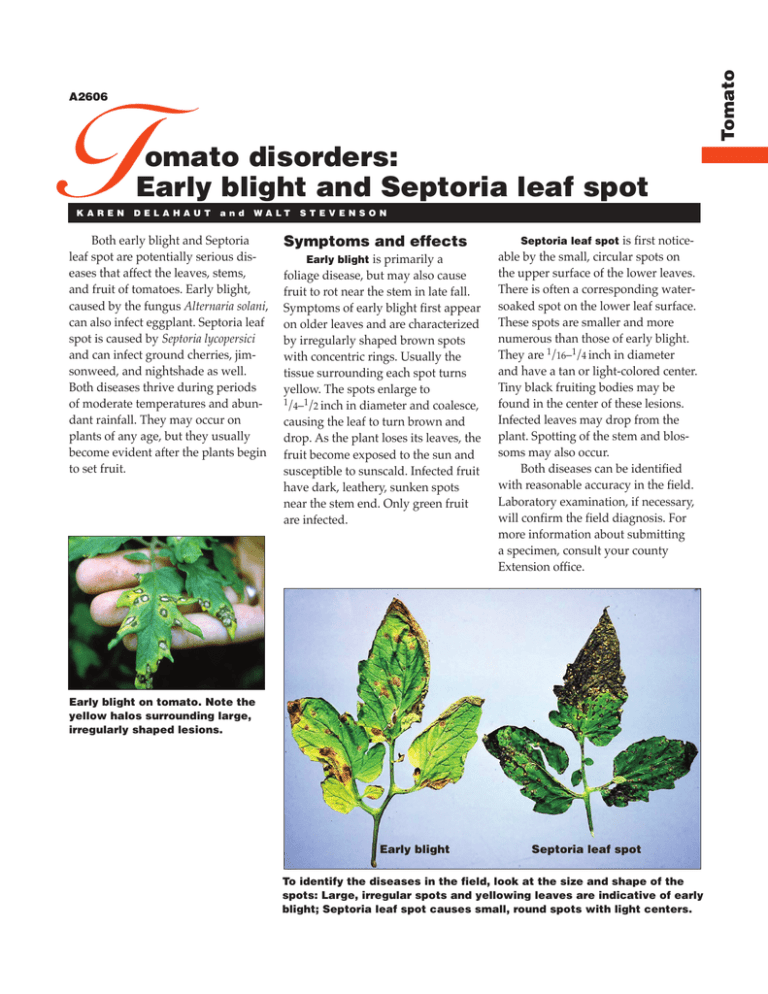
omato disorders: Early blight and Septoria leaf spot KAREN DELAHAUT and WA LT Both early blight and Septoria leaf spot are potentially serious diseases that affect the leaves, stems, and fruit of tomatoes. Early blight, caused by the fungus Alternaria solani, can also infect eggplant. Septoria leaf spot is caused by Septoria lycopersici and can infect ground cherries, jimsonweed, and nightshade as well. Both diseases thrive during periods of moderate temperatures and abundant rainfall. They may occur on plants of any age, but they usually become evident after the plants begin to set fruit. STEVENSON Symptoms and effects Early blight is primarily a foliage disease, but may also cause fruit to rot near the stem in late fall. Symptoms of early blight first appear on older leaves and are characterized by irregularly shaped brown spots with concentric rings. Usually the tissue surrounding each spot turns yellow. The spots enlarge to 1/4–1/2 inch in diameter and coalesce, causing the leaf to turn brown and drop. As the plant loses its leaves, the fruit become exposed to the sun and susceptible to sunscald. Infected fruit have dark, leathery, sunken spots near the stem end. Only green fruit are infected. Septoria leaf spot is first notice- able by the small, circular spots on the upper surface of the lower leaves. There is often a corresponding watersoaked spot on the lower leaf surface. These spots are smaller and more numerous than those of early blight. They are 1/16–1/4 inch in diameter and have a tan or light-colored center. Tiny black fruiting bodies may be found in the center of these lesions. Infected leaves may drop from the plant. Spotting of the stem and blossoms may also occur. Both diseases can be identified with reasonable accuracy in the field. Laboratory examination, if necessary, will confirm the field diagnosis. For more information about submitting a specimen, consult your county Extension office. Early blight on tomato. Note the yellow halos surrounding large, irregularly shaped lesions. Early blight Septoria leaf spot To identify the diseases in the field, look at the size and shape of the spots: Large, irregular spots and yellowing leaves are indicative of early blight; Septoria leaf spot causes small, round spots with light centers. Tomato T A2606 T O M AT O DISORDERS: E A R LY Disease cycle The early blight pathogen overwinters on infected plant debris where it can survive for 1 year, on seed, or in the soil. Septoria can survive for up to 3 years in infested debris, but it can also survive on weedy hosts such as jimsonweed, horsenettle, groundcherry, and nightshade. Initial infection occurs on the lower leaves and spreads upward in the plant as spores from infected leaves are splashed onto clean foliage by rain or irrigation water. Spores can also be spread if field work occurs while plants are wet. Control Rotate out of solanaceous (tomato family) crops for 3–4 years and control solanaceous weeds such as jimsonweed, horsenettle, groundcherry, and nightshade to reduce the build up of spores of both diseases in the soil. Use disease-free seed and inspect purchased transplants for leaf spots before transplanting into the field. Select a well-drained site with good exposure to the sun and wind to promote drying of the foliage after rain or dew. Space plants far enough apart to allow good air movement. BLIGHT AND SEPTORIA LEAF Staking or caging plants also helps speed drying of plants after wetting and keeps fruit and leaves off the soil. Do not water late in the day unless you are using trickle irrigation. Mulch will act as a barrier between the soil and foliage to prevent spores from splashing onto the leaves and fruit. Carefully monitor plants weekly once they begin to flower for early symptoms of these diseases. Pruning and destroying the lowest leaves will improve air circulation and hasten drying of the foliage after wetting. Removing leaves at the first sign of infection will also help slow the spread of the disease. At the end of the season remove or thoroughly incorporate all crop refuse. If the remains are buried deeply and decay, the fungi have less chance of overwintering. Do not compost infected vines unless you practice stringent composting practices that will assure prolonged heating to kill the disease organisms. There are presently no tomato varieties resistant to Septoria leaf spot. A few tomato varieties are reported to be tolerant to early blight, but they have not proven to perform well in Wisconsin. SPOT It may be necessary to treat tomatoes with protectant fungicides to control Septoria and early blight. Begin treatment when the first fruit clusters start to develop or when the first symptoms are observed. Some growers find that a few well-timed sprays control the diseases while other growers treat more frequently and still find that control is difficult. Applications of fungicide may be needed every 7–10 days when the weather is wet and warm. Observe the new foliage regularly to be sure that the sprays are effective. Copyright © 2004 by the Board of Regents of the University of Wisconsin System doing business as the division of Cooperative Extension of the University of Wisconsin-Extension. All rights reserved. Send copyright inquiries to: Manager, Cooperative Extension Publishing, 432 N. Lake St., Rm. 103, Madison, WI 53706. Authors: Karen Delahaut is senior outreach specialist with the fresh market vegetable program, Walt Stevenson is professor of plant pathology, College of Agricultural and Life Sciences, University of Wisconsin-Madison and University of WisconsinExtension, Cooperative Extension. Produced by Cooperative Extension Publications, University of Wisconsin-Extension. University of Wisconsin-Extension, Cooperative Extension, an EEO/AA employer, provides equal opportunities in employment and programming, including Title IX and American with Disabilities (ADA) requirements. This publication is available from your Wisconsin county Extension office or from Cooperative Extension Publishing. To order, call toll-free: 1-877-947-7827 (WIS-PUBS ) or visit our web site: cecommerce.uwex.edu. A2606 Tomato Disorders: Early Blight and Septoria Leaf Spot R-05-04
